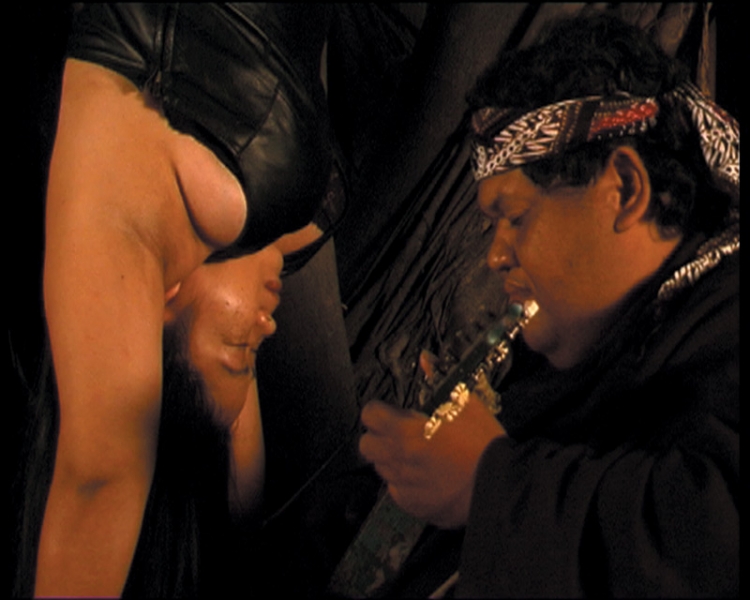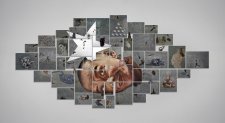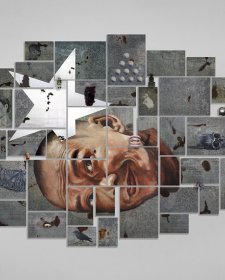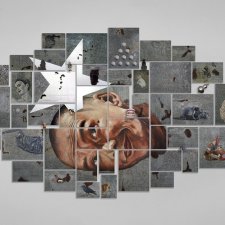Through the mediums of performance, video, photography and installation, Suryodarmo explores cross-cultural paradigms from the position of an insider and outsider; her European and Indonesian identity providing her with both opportunities and challenges to be explored through her highly physical and often humorously absurd performances.
As well as her arts practice, Suryodarmo is also the director of arts and cultural programming at Padepokan Lemah Putih in Solo, Indonesia, a non-profit institution that organises festivals, workshops, exhibitions, film screenings and interdisciplinary projects. As well as exhibiting throughout Europe, Southeast Asia and Australia, Suryodarmo participated in the Manifesta7 in Bolzano, she travels the world to undertake residency and performance projects. Suryodarmo lives in Germany and Indonesia.
Whirling energy
During our interview, Melati Suryodarmo said firmly, ‘I was born and raised in a Javanese family; although traditional it was no longer conservative, so in my body I’m still Javanese. My mother tongue is Javanese. I make no defence for this. However, I look at Java critically. Where is the Java that raised me?’[1]
What can we really imagine when an artist explains a matter that is personal and existential – her own body – in relation to her cultural background?
I don’t wish to imply that (the identity of) an artist is shaped absolutely by the colour of their social-cultural self. I want to interpret what is meant, in the context of Melati’s reality, by ‘my body is (still) Javanese’; I wonder if this is a kind of ‘body of a Javanese subject’ project. That subject has at least (once had) roots – in the past – in the primary values of Javanese culture, which are still vibrantly felt.
Thus, the deepest Javanese philosophy would assert that the Javanese subject (person) is none other than a subject with ‘understanding’. Understanding in this matter is not ‘the wealth of human cognition’; conversely, it is something that can better be described as rasa.2 Through this, Javanese people can better know their own reality.3
After spending nearly half her life in another country – Germany – Melati Suryodarmo, the Javanese subject, is proud to name her motherland as Solo, centre of Javanese culture and often associated with the classical arts. It was not, though, the classical vocabulary that attracted Melati’s attention. In the beginning of the 1990s, she witnessed Joseph Beuys’ Coyote: I like America, America likes me 1974, which planted a strong and growing impression in her imagination. Beuys ‘landed’ in America without ever stepping foot in that country.
Since then, performance art has moved Melati, feeling that it offers a challenging freedom of thought. For her the body in performance is a primary medium, genuinely containingmeaning – that is, the physical body that is used, and the cultural body as the source and actor.4
Does the physical body more strongly inform Melati’s experience of being ‘German’, and is the perceptual subjective body her Javanese body-project? Maybe we won’t find a precise answer; in any case, we are subjects within the existence of the body. Perhaps the authenticity Melati wishes reconcile is ‘level of sensation’, as recognised by the Javanese perspective on rasa. In saying this, I don’t want to state that art works simply submit to some kind of normative system or existing culture, but art works can be tested, as Joan Kee said, as a kind of situation, in relation to other woks, in effect to reveal their own transparency as a node of connections.5
In the video performance, Pass to Converse 2003,Melati tests the differing spiritual powers encountered between a Javanese mantra recited by a dalang, and sacred poetry spoken by a bissu (narrator)of South Sulawesi traditions. Melati’s body is upside down, indicating the strain she experiences between positionality and representativity. “… what bearing (do) social and cultural discourses have on individual experience … how much (do) any of us share with each other?”6 The ‘Javanese body’ has given Melati depth of intuition (rasa ), but she does not want to be burdened by history.
As Melati says: ‘When I’m geographically separated from my traditional environment there is a kind of longing to see again what is behind performances of ritual I’ve witnessed. I don’t feel directly influenced by those ritual performances, although I question the myths and thought processes which somehow lead to the formation of those kinds of rituals. And I ask again, why is my body unaware but seemingly obliged to be burdened by the history of my ancestors? Lullaby for the Ancestors 2001attempts to cross those borders....”
One of the performances that attracts the most attention and demonstrates the intensity of the subjective body is Exergie – Butter Dance 2000.Melati has called that ‘the artwork that I have been conceptualising all my life. I want to repeat it as I journey through aging and my body changes. When I created it, I departed from the understanding of nihilism in the process of spirituality. I’m sure that there is a nihilistic space, when I face the extreme changes in my body. It has a connection with seeing the precise timing it takes to save a life.’
The creation of that performance is like offering up images of falling, as her artist colleague Boris Nieslony commented.7 For me it is feeling the rotation of energy in the space or stage where Melati’s body falls ever more quickly, it is as if I am witnessing a windmill revolving horrifically; it spits each time it regains its balance, struggles, totters, falls, then stands again. It manifests as the most astonishing symbol of the contingency of the body that I have witnessed from a performance artist.
Hendro Wiyanto
Independent curator, Jakarta, Indonesia
1 Interview with Melati Suryodarmo, email, 26 May 2011.
2 Rasa, in Indonesian, is conventionally translated as ‘feeling’ or ‘taste’.
3 Franz Magnis-Suseno, Etika Jawa Sebuah Analisa Falsafi tentang Kebijaksanaan Hidup Jawa, Jakarta: PT Gramedia, 1985 (pp. 199–200).
The mystical movements or the foremost Javanese spirituality will differentiate between thought (mind) and rasa. Thought is the means by which we organise information that we receive through our senses from the external world; then there is rasa that is used by Javanese to understand the truth of alam batiniah (natural morality).
4 Op. cit. interview with Melati.
5 Joan Kee, ‘What is Feminist About Contemporary Asian Women’s Art?’ in Global Feminism New Direction in Contemporary Art, edited by Maura Reilly, Linda Nochlin, London/New York: Merrell Publishers Limited, 2007.
6 The problem is not just how to recognize the existence of specific groups who may have alternative perspectives and may not subscribe to dominant discourse within any particular setting. The more pressing problems with regard to gender, the body and sexual difference is to work out … (see Henrietta L. Moore, A Passion for Difference, Essays in Anthropology and Gender, Cambridge: Polity Press, 1994, p. 16).
7 Melati Suryodarmo, Loneliness in the Boundaries ; Goethe Institute Jakarta, Yogyakarta: Cemeti Art House, 2006.














